ON AND OFF THE ANTIQUES ROADSHOW
Many of you will remember ‘Going for a Song’. It was the forerunner of ‘The Antiques Roadshow’ and ran from 1965 to 1977 with Arthur Negus as its main antiques valuer and Max Robertson as its presenter. Arthur went on to record a pilot programme for the first ‘Antiques Roadshow’ in 1977, which proved so successful that it has continued in almost the same format ever since.
The programme’s first presenter was Bruce Parker (of ‘Nationwide’ fame) until 1979. Angela Rippon followed for a brief period and then Hugh Scully took over for a long spell until 2000. Arthur stayed with the programme until 1983 when he retired. He died in 1985.
My involvement could be said to have started in the late 1960s when I was working on the main reception counter at Sotheby’s. In those days the specialists would value items at the counter and it was an invaluable learning experience. From reception I did a short stint in the silver department where it was easy to learn the marks, although I’ve always found silver somewhat cold and characterless. I then progressed to the furniture department where I learned about pre-Victorian furniture – anything after George IV was considered ‘modern’ in the 1960s! Early furniture has remained my favourite discipline.
In those days antique dolls and automata were included in the back of the furniture catalogues, and one of the furniture directors, Charles Walford, took it upon himself to catalogue them. Charles was very generous with his knowledge and taught me a great deal, and although I have never been a ‘dolly’ sort of person, I became interested in the domestic history behind them.
In the 1970s Sotheby’s had an affiliation with a west country auction house and one of their specialists sent Charles a photograph of a doll asking if it was Chinese. I recognised this doll and said that it was of international importance and should be included in a London auction. Charles and I were duly instructed to get on a train to Cornwall to collect this doll and bring it to London. On the train Charles suggested we go to the restaurant car for a cup of tea, and there he told me that, as I now knew as much if not more about the subject as he did, he had been instructed by the directors to ask me if I would like to start a department devoted entirely to dolls and automata. Of course I said I should be delighted!
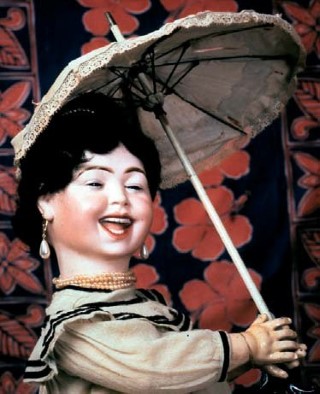
The west country doll was the star lot in my first sale in 1982 (See Illustration 1) and indeed created a first auction record for a bisque doll of £6,000. In the Daily Telegraph the next day there was a photograph of me holding the doll, our faces in profile looking at each- other with the caption ‘Bunny Campione with the new world record doll (Bunny on the left)!’ It was in fact a rare Jumeau ‘character’ doll, mould number 208, French circa 1889.
In 1983 I went on to stage the first Teddy bear auction and, after publicity of further auction records, more and more dolls, automata and soft toys started to be brought to the Roadshow. As nobody else wanted or was able to value them, my name was put forward for the Roadshow.
My first ARS was horrible – I think it was in a sports hall in Bournemouth. David Battie kindly brought me a pile of magic lantern slides, glass in wooden frames, and asked me if I’d like to record them. I gratefully accepted and gingerly took them from him, but one of them was loose in its frame – it slithered to the ground and smashed into smithereens, whereupon I handed the rest back to David, burst into tears and rushed to the loo! What on earth was I doing on this terrifying programme?
It took me a long time to stop being extremely nervous, and even now I find it a nerve-wracking experience. It was only when I realised that the people with whom I was filming were much more nervous than I was that I started to relax a little. Sometimes these people have been waiting for several hours, during which time both men and women have to be professionally made up, and it is not unknown for some women to go off to the hairdresser. Most of these people have never been on television so it can certainly be a daunting experience. Hugh Scully used to say it was a conversation between two people with 14 million eavesdroppers!
For anyone who has never been to the Roadshow it is a fairly sizeable operation. People I’ve met who have been to it all say they were amazed at the enormous amount of organising and professional planning that must have gone into it. An average attendance is 3,000 visitors during the one day, and apparently the number of objects valued can be as many as 20,000. There are approximately 30 technicians/ directors and crew, and 20 specialists. Most of the filming is outside now, whereas in the old days we filmed in sports halls as well as inside large houses. Of course the British weather can be very unkind, and it is on those occasions when we have to crowd into a tent which is never large enough to accommodate all of us and the public as well.
One of the worst outside broadcasts was at the Castle of Mey on the north coast of Scotland, home of the late Queen Mother. Not only did it rain heavily the whole day, but the wind got up to such as extent that you could hardly hear yourself speak for the pounding of the rain while filming in the tent. The organisers had been worried that we wouldn’t get enough public to come to the venue so they laid on a ferry from Orkney for the day. The only trouble was that by the end of filming, when the ferry was due to take them back, the wind had become so strong that the ferry was cancelled and the poor people had to find accommodation in the surrounding villages!
For anyone coming to a show for the first time, having parked your car, maybe a few hundred yards away, you start by queueing. In Accrington many years ago the queue started at 5.30a.m. During the night, the temperature had plummeted to minus 10 degrees, and by the time the gates opened there was a woman who had a metal synthetic ear which had frozen to her head. Before she was taken to hospital by St. John’s Ambulance (always on duty) she insisted on having her porcelain bowl valued by David Battie!
Twelve years ago, for the ARS’s 25th birthday, one man was determined to be the earliest person to queue on the day and that was 12.01am! He was a baker and had baked a special birthday cake to present to the show. There was a sugar Teddy bear on the top and he wanted to present the cake to me and Michael Aspel. Michael, a little unkindly I thought, insisted I give him a hug – not a pleasant experience with someone who has been up all night and was sweating with excitement…
At the head of the queue is the Reception desk where four general valuers ask to see what you have brought along to be valued. If you have a piece of porcelain you are given a slip of paper printed ‘ceramics and porcelain’; if you have a picture you are given a ‘picture’ slip. If you also have a piece of jewellery and a book – there is no limit to the number of pieces people can bring – you end up with four slips of paper and then start queueing to see a specialist at one of those tables.
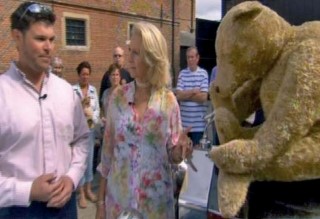
It can take several hours of standing, sometimes on concrete, sometimes on wet grass and very often in the rain before people are seen. I once filmed a 90 year-old with her doll who had been queueing for four hours! She was a bit deaf so I don’t think she heard me value her doll at £800, but she pulled the doll to her face and kissed it and said ‘I’ll never sell you, darling Rosalie’. It made good filming.
We specialists are always encouraged to find out as much as we can about the history behind a piece we want to film, but we never tell the owners the value or anything else about it until we film. Reactions are therefore always spontaneous. Out of approximately 27 reels of film only about two are used for any one show. Rather surprisingly, we specialists never know if we have been cut, while the person who has been filmed will be told in advance if he or she is on and the date it will be shown.
Large pieces which cannot easily be carried to a Show are brought in the day before. We call this the ‘Furniture Round’. Two months before filming, advertisements are put in stationers, shops and libraries of the nearest town, encouraging the public to send to the BBC in Bristol a photograph with dimensions of anything too big to bring on the day, and a removal van and driver with a general antiques valuer visits each home. Sometimes they go to pick up a table and might see an interesting picture on the wall and suggest they bring that too. The owners are promised the pieces will be valued but not necessarily filmed. They are also given an entry ticket so they don’t have to queue.
There are two types of camera: one is called a PSC (or portable single camera), together with a director and sound and lighting technicians. This team can film short pieces without too much waiting around for the public. It is fine for a short piece which doesn’t need too close a shot. It is one of these teams who film the presenter going round the venue. The other film crew is a much larger set-up with around four or five cameras, two producers, directors, floor manager, lighting and sound technicians. There is also a producer’s assistant who monitors the list of filming every quarter of an hour throughout the day.
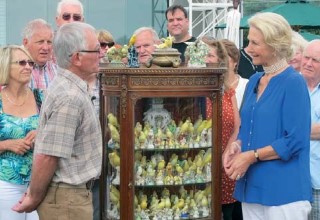
If someone brings a really exciting piece to the Show towards the end of the afternoon it is more than likely that the filming list is full and it has to be turned down. This happened when we made two programmes in the Channel Islands, Guernsey on the Tuesday followed by Jersey two days later on the Thursday. Eric Knowles particularly wanted to film a rare porcelain item in Jersey, but unfortunately the woman brought it in too late, so the producer told him to suggest to her that she bring it to Jersey, where he would make sure it was filmed. When Eric relayed this message the woman was heard to exclaim “Young man, if you think I’m going to let myself be seen by all my friends filming on Jersey you are very much mistaken!” (There is still an underlying hostility between the two islands, ‘old’ money and ‘new’!)
On Guernsey a very old lady brought an 18th Century wooden doll. We filmed this on the PSC and just before we started filming I asked her if the doll had a name and she said it didn’t. The camera showed the whole doll, with me pointing out various things including the wooden hip joints and the lack of any knickers, thus emulating 18th Century ladies of the day. I then pulled her dress down at the bust to show her moulded wooden bosoms and pointing out that the dress was 19th Century while the doll was 18th Century.
At the end of each recording the camera has to zoom in for close-ups of all the places we have picked out, which are known as ‘cut-aways’. Just before we started filming the old lady said to me “Do you mind if I call my doll Bunny?”; of course I said I should be delighted. The director continued the filming, asking if I could pull up ‘Bunny’s’ skirts again to show that ‘Bunny’ wasn’t wearing any knickers, and to pull down the top to show ‘Bunny’s’ bosoms! By this time we were all falling about giggling so much that the piece was eventually cut, probably due to our behaviour!
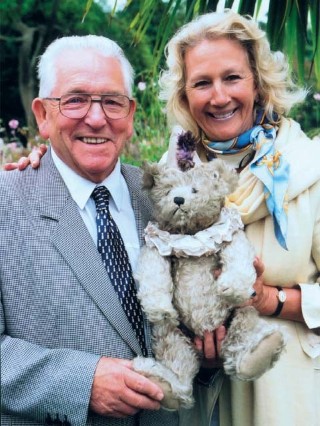
I also unwittingly caused some amusement at Layer Marney. An extremely large Teddy bear was put on the bonnet of Nick Charrington’s vintage car on one side of me, with the owner on the other side, an audience of several people standing behind us (see Illustration 2). The floor manager’s arm indicated and I started filming. Looking at the Teddy bear I said “I’ve never in 25 years had one as big as that before”, and I turned to look at the owner who was convulsing with laughter, as were the onlookers behind me. I suddenly realised what I’d said and compounded it by saying “I mean a Teddy bear”! The producer e-mailed me the day before it was shown, apologising but saying that it was too amusing to cut!
At The University of East Anglia I was singled out to film a large group of porcelain canaries which a man had collected over the years. Very appropriate with Norwich City called ‘The Canaries’! (See Illustration 3).
In Northern Ireland when we filmed at Mount Stewart, a delightful Irishman brought in a Teddy Bear. He said it had been kept in a bag in a cupboard and a dealer had suggested he take the bear to London and perhaps he could get £2,000 for it. I recognised this bear as a rare Steiff ‘Clown’ bear of 1928 and told the owner to add a nought. He reacted wonderfully and said in his lovely lilting Irish accent ‘Will you ask somebody to take me home in a wheelchair?’ ! (See Illustration 4).
Sometimes between recording a piece and when it is shown to the public, the owner has decided to sell it. The Mount Stewart clown bear was just such a one. I get all the toy catalogues and in a Christie’s catalogue what should be coming up for auction but this bear. Of course my valuation of £20,000 was pretty high and it worried me that if the bear was knocked down in the saleroom for £10,000 or less, I would look a fool. The day of the auction arrived and I nervously hid behind a pillar. The bidding hovered around £10,000 and then stopped. I gulped. Finally it continued, and eventually the hammer came down at £20,000, which, with the buyer’s premium, was £22,000. I was saved.
I love filming in Ireland; we’ve had some quirky and amusing stories there. At one venue first thing in the morning when the doors open at 9am an Irishman was at the head of the queue and Eric Knowles valued his tea- set. By 3pm the same man was again at the head of the queue, with the same tea-set, and when Eric said he thought he had told him all he wanted to know about it, the man said “Oh yes, I know, but I thought you were such a nice man I’d come and see you again”!
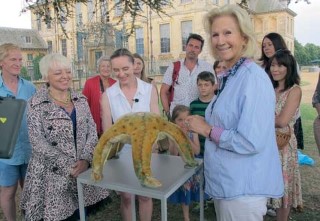
The BBC has filmed many Roadshows overseas. In each case the host country pays for us to go there so the costs don’t come out of the British public’s purse. We’ve been to Jamaica, Scandinavia, France, Belgium, Holland, Australia and Canada.
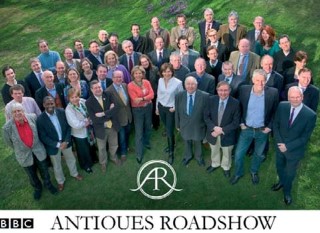
In this year’s recent filming we went to Barrington Court in Somerset, and two sisters brought in a most unusual Steiff starfish stool (you try saying that when you are filming!) The talkative sister looked just like a blonde version of Liza Minnelli (See Illustration 4)
Many letters are written to the BBC about the show or the specialists, some are personal. The BBC forward these to us and reply to the sender saying that we may not reply. I’ve had letters from two different prisoners in different prisons, who both said they wanted to be my pen-pals! Antiques Roadshow venues for 2015 will be available soon on www.bbc.co.uk/antiquesroadshow
Bunny Campione
I am grateful for yet another article from Bunny Campione who happens to live in the same village as myself, Lamarsh. She, and her husband, Iain Grahame, have been regular contributors, and Iain has an article on Badgers elsewhere in this issue.

